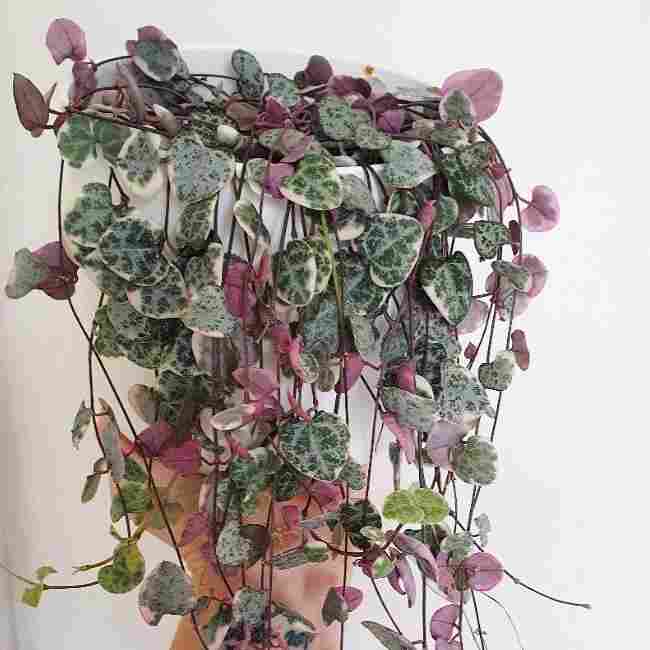String of Hearts Variegated, Ceropegia woodii Variegata
Original price was: ₹320.00.₹199.00Current price is: ₹199.00.
Out of stock
Email when stock available
Selling size: Well rooted plant in a jiffy bag (About 16-23cm length available)
The String of Hearts Variegated ( Variegata) is a beautiful trailing succulent known for its heart-shaped leaves with shades of green, cream, and often vibrant pink or purple edges.

Here’s a comprehensive guide to String of Hearts Variegated, Variegata‘s care:
1. Light:
- Bright, Indirect Light is Key: This is the most crucial factor for maintaining its vibrant variegation (especially the pink hues). Aim for 4-6 hours of bright, indirect sunlight daily.
- Ideal Placement: A south or east-facing window is often ideal, where it can receive filtered light for several hours. A west-facing window can also work if the afternoon sun isn’t too harsh.
- Avoid Direct Sun: While it can tolerate some gentle morning sun, too much direct, intense sunlight, especially in the afternoon, can scorch the delicate leaves and cause the pink variegation to fade.
- Insufficient Light: Not enough light will lead to leggy growth (stretched vines with widely spaced leaves) and a loss of the vibrant pink coloring, causing the leaves to revert to a more solid green. If natural light is limited, consider using a grow light.
2. Watering:
- Drought Tolerant (But Don’t Let It Shrivel): As a succulent, the String of Hearts stores water in its leaves and is prone to root rot if overwatered. It’s much better to underwater than overwater.
- “Soak and Dry” Method: Allow the soil to dry out completely between waterings. You can check by feeling the top few inches of soil. Some experienced growers even wait until the leaves, particularly those closer to the crown of the plant, start to feel slightly less plump or even a little flexible.
- Water Thoroughly: When you do water, water deeply until water drains from the bottom of the pot.
- Reduce in Winter: During the cooler, dormant months (fall and winter), reduce watering significantly as the plant’s water needs decrease.
- Signs of Under/Overwatering:
- Underwatering: Wrinkled, shriveled, or curling leaves.
- Overwatering: Yellowing, mushy, or dropping leaves, often accompanied by soft stems and a risk of root rot.
3. Soil:
- Well-Draining is Essential: Use a well-draining soil mix that prevents waterlogging.
- Recommended Mixes: A cactus or succulent potting mix is ideal. You can also amend regular potting soil with perlite, coarse sand, or coco coir to improve drainage.
- Acidity: These plants prefer slightly acidic soil, with a pH range of 4 to 6.5.
4. Temperature and Humidity:
- Temperature: Prefers average room temperatures, ideally between 18°C – 27°C (65°F – 80°F). Protect it from temperatures below 10°C (50°F) and cold drafts, as it is not frost-tolerant.
- Humidity: Average to high humidity is fine. Normal household humidity is usually sufficient, but it appreciates some humidity. If your air is very dry, you can mist occasionally, but ensure good air circulation to prevent fungal issues.

5. Fertilizer:
- Light Feeder: String of Hearts doesn’t require heavy feeding.
- Frequency: Fertilize sparingly, once a month during the active growing season (spring and summer), with a diluted, balanced liquid fertilizer designed for houseplants or succulents.
- Avoid in Winter: Do not fertilize during the dormant fall and winter months.
6. Potting and Repotting:
- Drainage Holes: Always use a pot with drainage holes to prevent water from accumulating and causing root rot.
- Pot Size: String of Hearts prefers to be slightly root-bound. Don’t rush to repot, and when you do, only go up one pot size (e.g., 5 cm or 2 inches larger in diameter).
- When to Repot: Repot when the plant has stopped growing or becomes too top-heavy, typically every 12-18 months for smaller plants, or 18-24 months for larger ones. Spring or summer is the best time.
7. Propagation:
- Variegated String of Hearts is relatively easy to propagate, especially in spring and summer. Common methods include:
- Stem Cuttings (Water or Soil): Take cuttings with several nodes (where leaves emerge). Remove the bottom leaves and either place the nodes in water until roots form, or directly plant them in moist, well-draining soil. High humidity helps with rooting.
- Tuber Propagation: Healthy plants often produce small, bead-like aerial tubers along the vines. These can be placed on top of moist soil (slightly buried) to root, either while still attached to the mother plant or as detached cuttings.
- “Butterfly” Method: Cut individual leaf pairs with a short piece of stem on either side (resembling a butterfly). Lay these on moist sphagnum moss or soil in a high-humidity environment.

8. Common Problems:
- Leggy Growth/Fading Variegation: Insufficient light. Move to a brighter location.
- Yellowing/Mushy Leaves: Overwatering. Let the soil dry out more between waterings and ensure good drainage.
- Wrinkled/Shriveled Leaves: Underwatering. Water more thoroughly when the soil is dry.
- Bare Top, Full Sides: Not enough light from above. Ensure light reaches the top of the pot. You can also pin down nodes onto the soil surface to encourage a fuller top.
- Pests: Generally resistant, but can occasionally get mealybugs or spider mites. Inspect regularly and treat with insecticidal soap or neem oil if necessary.
- Toxicity: String of Hearts is considered toxic to pets, so keep it out of reach of curious animals.
By providing the right balance of light, water, and well-draining soil, your String of Hearts Variegated, Ceropegia woodii Variegata will thrive and display its beautiful, unique foliage.
Only logged in customers who have purchased this product may leave a review.












 If you need any assistance, I'm always here. Have you found what you were looking for?
If you need any assistance, I'm always here. Have you found what you were looking for?
Reviews
There are no reviews yet.